Update - See the latest SERP feature developments in our guide to Google's 2024 SERP features.
Google’s search results have long surpassed the days of simple blue links.
Now, with over 17 different SERPs features, search results are more dynamic than ever – and there are countless opportunities for your content to appear in the top spaces.
Understanding Google’s SERPs features and how to optimise your content for them is key.
Keep reading as we guide you through Google’s latest SERPs features.
Table of contents
- What are SERPs features?
- How SERPs features impact website engagement
- What are the benefits of SERPs features?
- How does Google decide what SERPs features appear?
- Google's 2023 SERP features
- Organic SERPs features
- Paid Google SERPs features
- Final Word
What are SERPs features?
SERPs features are anything that appears in search engines’ results pages that aren’t regular blue links.
They typically appear at the top of search results, and their purpose is to provide quick, relevant information directly on the results pages, sometimes without needing to click through to a specific website.
There are organic SERPs features and paid SERPs features. We’ll explain both below.
How SERPs features impact website engagement
With the purpose of Google’s SERPs features being to keep users on Google’s pages, some argue that website engagement has inevitably declined due to the convenient nature of search results.
Whilst decreases in traffic have been observed across industries over the last few years, the flipside is that appearing in SERPs features has a significantly positive impact on website traffic and engagement.
Which means that it’s more important than ever to optimise content for SERPs features.
Not only this, but the quality in traffic is arguably better thanks to Google’s commitment to answering users’ queries as efficiently as possible - thus reducing the need to bounce around for the right answer.
What are the benefits of SERPs features?
By nature, appearing in SERPs features – usually at the top of search results - increases the visibility of your brand and content to users, and therefore the chances of users clicking through to your website.
Although the purpose of SERPs features is arguably to keep you on search engines’ results pages – rather than taking you away to websites – the increase in visibility often results in a significant boost in traffic to your website.
Appearing in some SERPs features has more benefits than others though. For example, appearing in Rich Answers which provide instant answers to simple questions like ‘How tall in Big Ben?’ is unlikely to drive traffic to your website as links are not included. Whereas People Also Ask can result in a welcome boost of traffic, since users are likely in a deeper research phase – and more likely to click through to your website from the FAQs.
How does Google decide what SERPs features appear?
The specific factors that influence the presence of SERPs features can vary depending on the search query and context, but here are some general considerations:
-
Relevance: Google aims to provide the most relevant results for a user's query. The algorithm evaluates the content and structure of web pages to determine their relevance to the search query. SERP features are designed to enhance the search experience by providing additional information directly on the results page.
-
User Intent: Google tries to understand the intent behind a search query. Based on the user's intent, the algorithm may display specific SERP features that are likely to meet the user's needs. For example, if the intent is to find a local business, Google might show a map pack or local pack with relevant listings.
-
Quality and Trustworthiness: Google considers the quality and trustworthiness of web pages when determining SERP features. Pages that are considered authoritative, have high-quality content, and meet Google's guidelines are more likely to be featured prominently.
-
User Experience: Google takes into account the overall user experience when displaying SERP features. The algorithm considers factors such as page load speed, mobile-friendliness, and ease of navigation. Pages that provide a positive user experience are more likely to appear in SERP features.
-
Search Volume and Trends: Google analyses search volume and trending topics to identify queries that warrant specialized SERP features. For example, for popular queries related to movies, Google might display a dedicated movie carousel or showtimes directly on the results page.
-
Format and Structured Data: Web pages that utilize structured data markup can provide additional context to Google's algorithm. By using structured data, website owners can indicate specific details about their content, such as reviews, ratings, recipes, events, and more. This information can increase the chances of being featured in relevant SERP features.
Google's 2023 SERPs features (and how to get into them)
Here are some of the most common Google SERP features and our tips on how to optimise your content to appear in them.
Organic SERPs features
1. AI generated responses (updated)
Since Google's announcement in May 2023 about their AI SERP feature, the AI generative responses have been introduced. They are currently live in the US and testing in the UK.
This feature uses an advanced large language model (LLM) to provide more detailed and contextually relevant answers directly within the search results. For a detailed overview of how this feature works and its impact on search, see our article covering the release of Google's AI Overviews.
2. Featured Snippets
A Featured Snippet is the reverse of a normal blue link search result. It appears at the top of Google's search results page in a box format with text and a link to the source website below. Text that appears above the link can often present as bullet points (taken from subheadings in the website content) or an excerpt of a paragraph.
The below images show searches that ask for summarised information or ‘how to’s’ about a particular topic often retrieve Featured Snippets.
How to appear in Featured Snippets: Content that informs or instructs users about a particular topic – such as ‘how to’ and ‘what is’ content – often appears in Featured Snippets. This type of content also includes numbered bullet points and has a good amount of subheadings that answer relevant questions to the topic. Creating content that appeals to these structures, and that is well laid out has a good chance at appearing in this SERP feature.
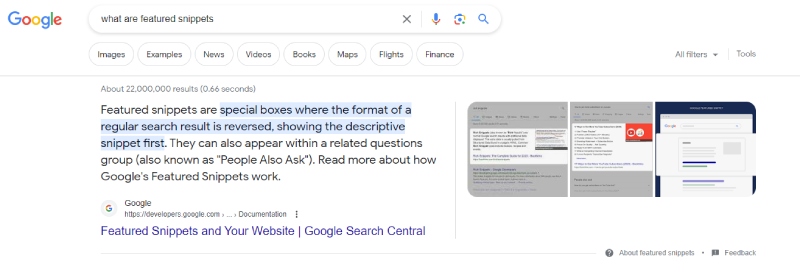
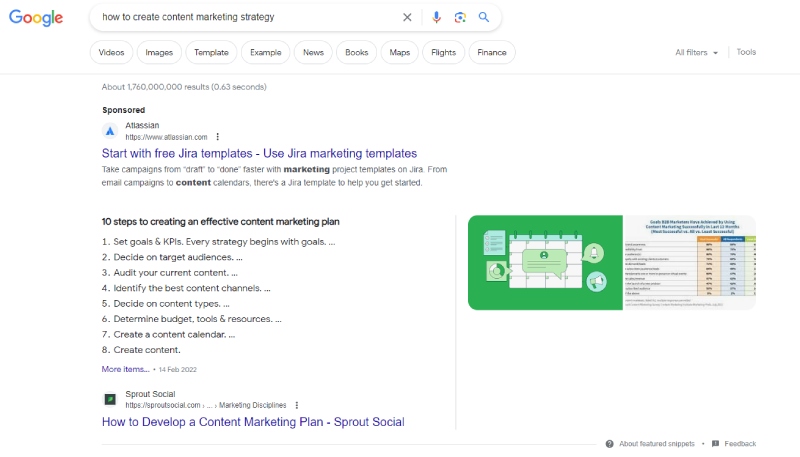
3. People Also Ask
The 'People Also Ask' (PAA) SERP feature is a dynamic section that appears in Google search results, displaying commonly asked questions related to the user's query. By clicking on these questions, users can expand and explore additional answers, which may lead to a more comprehensive understanding of the topic or query they are searching for. As one answer is expanded, more appear below.
How to appear in People Also Ask: If you have a topic in mind, start by observing the existing People Also Ask results for that topic. Look at ways you can answer the questions better than the current pages in People Also Ask. Use the questions as subheadings in your content and answer them concisely.
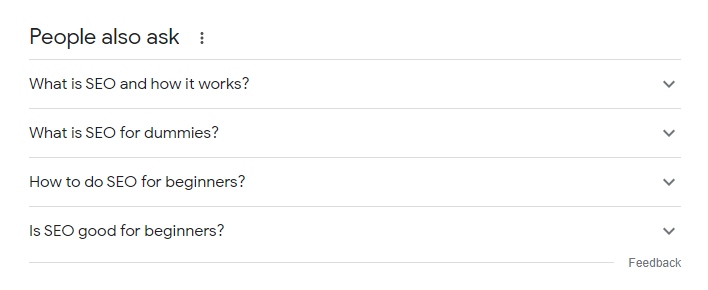
4. Rich Answer
The 'Rich answer' SERP feature, also known as a direct answer or instant answer, is a concise and directly displayed answer to a specific query or question on a search engine results page. It aims to provide users with immediate information without requiring them to click through to a specific website.
The below image shows how basic questions, such as ‘How tall is the Eiffel Tower’, retrieve quick Rich Answer SERP features to answer the query.
How to appear in Rich Answer: Create content that answers FAQs that are relevant to your brand – think about including statistics in your content, and work to create concise responses to popular questions.
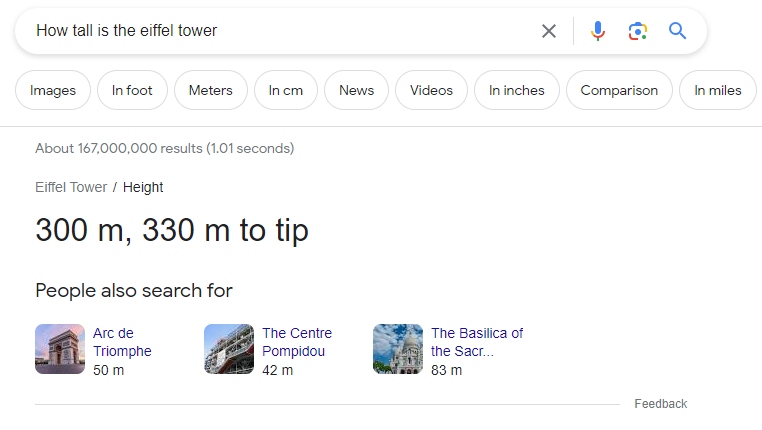
5. Rich Snippets
Rich snippets or ‘Rich Results’ are classic Google search results (blue links), but with additional information displayed, such as reviews, recipes and events/dates. They are taken from Structured Data found in a page’s HTML. They provide a more engaging search result that can help your website stand out from others.
How to achieve Rich Snippets: Ensure your schema markup (or structured data) is added to the source code of your webpage. We also recommend auditing your schema markup occasionally, particulalry if your pages are failing to appear as Rich Snippets. It could be that there are errors in the structured data.
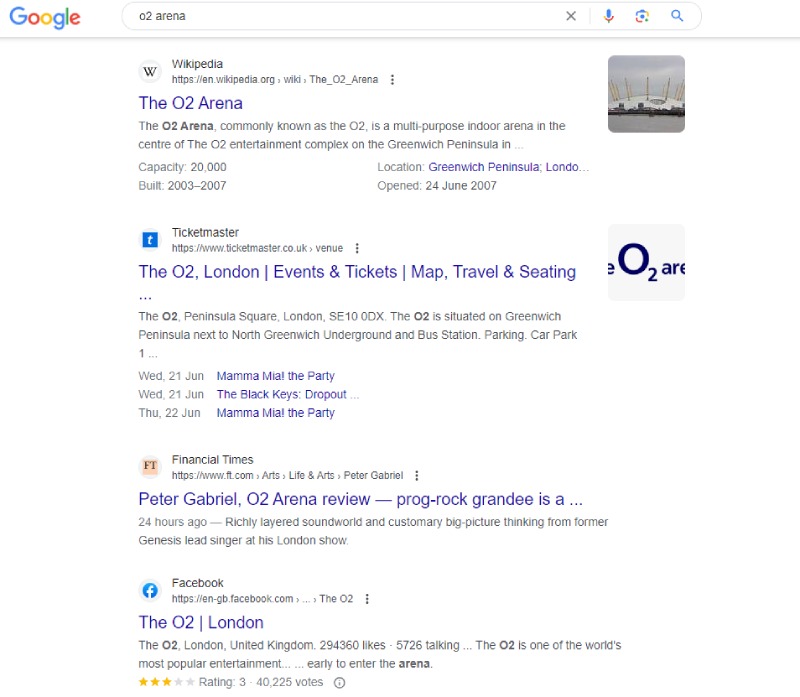
6. Rich Cards (mobile)
Rich cards appear in mobile search results and show a carousel of results – for example a carousel of links to recipes, using structured markup data to display content.
How to appear for rich cards: Ensure schema structured data / schema markup is implemented on your mobile webpages.
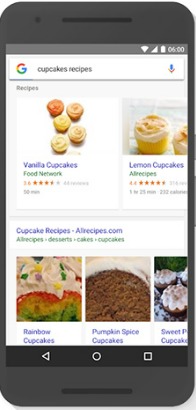
7. Top Stories
The 'Top stories' SERP feature highlights the latest and most relevant news articles and updates related to a specific topic or keyword. It provides users with immediate access to recent news and allows them to stay informed without having to visit multiple news websites.
How to appear in Top Stories: Be ahead of the curve – factor in ‘reactive’ content to your content calendar to ensure you are staying on top of topical stories. Recent articles about a trending topic can get you featured in Top Stories. Use trend watching tools like Semrush and Google trends.
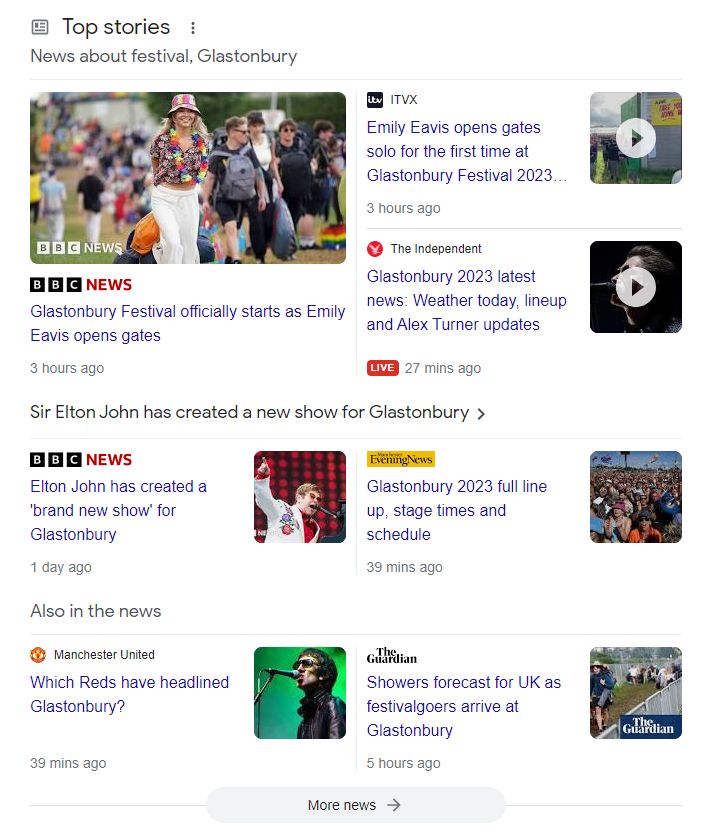
8. Knowledge Panel
The 'Knowledge Panel' or ‘Knowledge Card’ is a prominently displayed information box that appears to the right of Google’s search results, providing detailed and structured information about a specific entity or topic. It provides an overview of the searched person, place or thing and often includes key facts, images, and links to social media profiles or related sources (e.g. Wikipedia), and interactive features – such as 'People also search for' links.
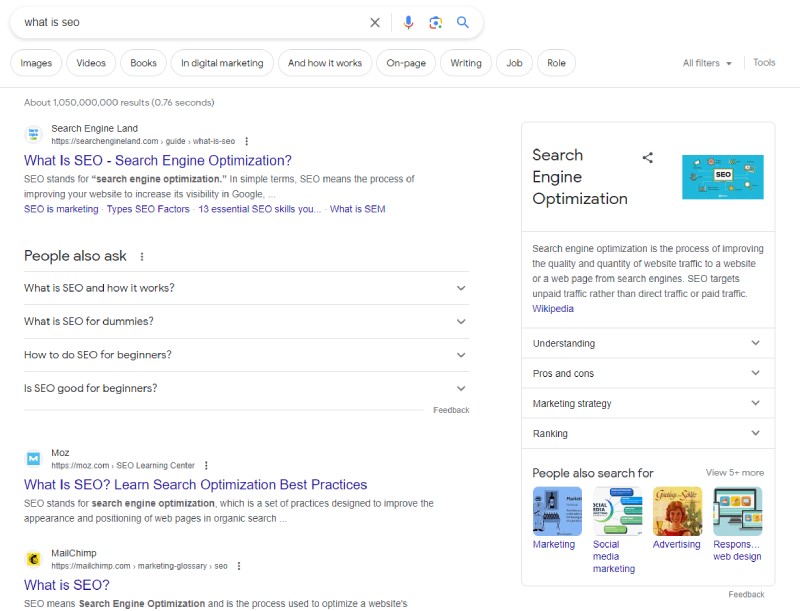
If there is a wealth of information or content related to the search topic, a Knowledge Panel may also be served along side a selection of tabs or full courasel that runs along the top of the SERP. As shown in the below image, these carousels offer easy access to a variety of content related to the query, such as images, videos, books, and other media.
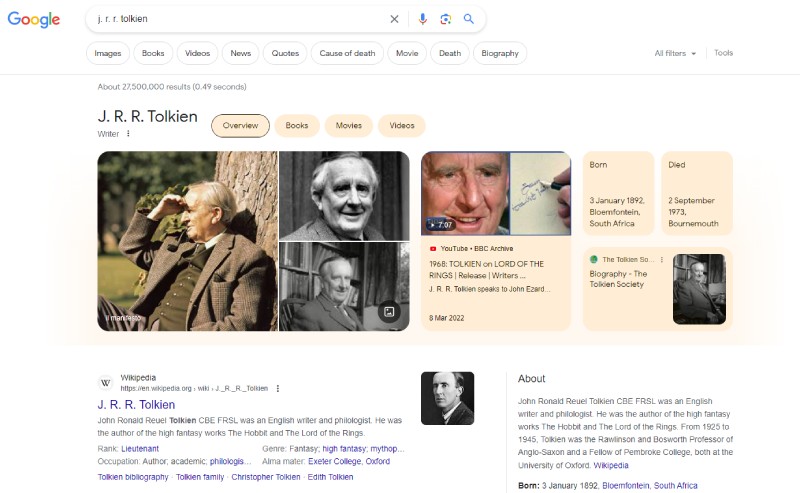
9. Local 3-pack
The 'Local 3-pack' SERPs feature is a display format in local search results that shows a compact listing of three local businesses related to a specific query or location. It includes essential information such as business names, addresses, phone numbers, ratings, and reviews, providing users with a concise snapshot of nearby options in their search for local services or products.
How to appear in local 3-pack: Make sure your Google Business profile is as up to date as possible, include relevant keywords in things like service description and company description, and be sure to add all of your service areas. Discover more tips to optimise your Google Business profile for local visibility here.
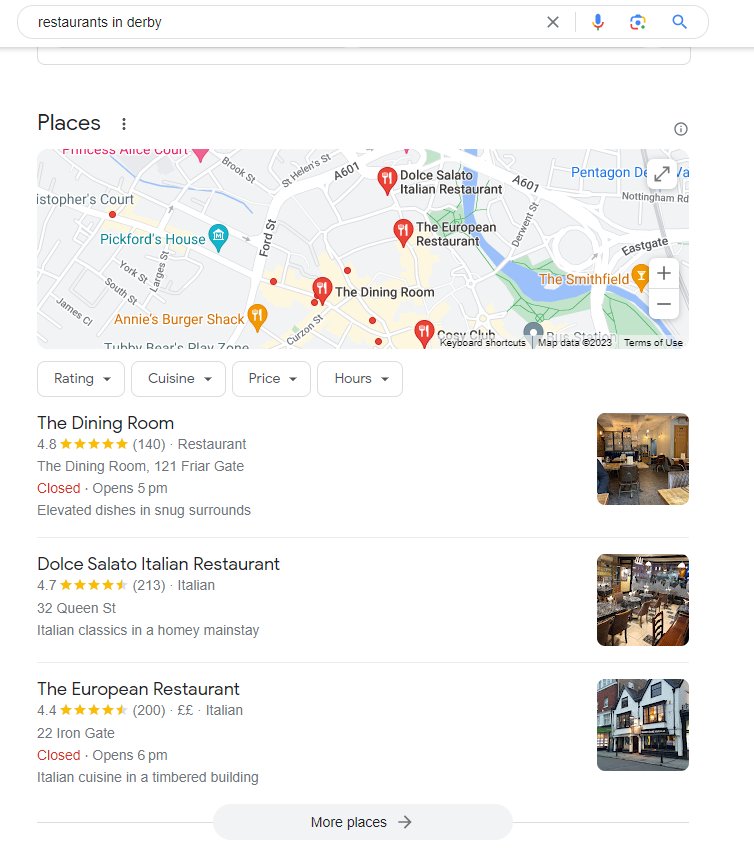
10. Image Packs
The 'Image Packs' SERPs feature is a collection of images that appears in search engine results pages, typically displayed as a grid or carousel. It provides users with visual content related to their search query, allowing them to quickly browse and explore relevant images without having to visit individual websites or image search platforms.
How to appear for Image Packs: Try creating infographics to accompany website and social content, and include original images where possible. Make sure to add alt tags to describe what the image is showing.
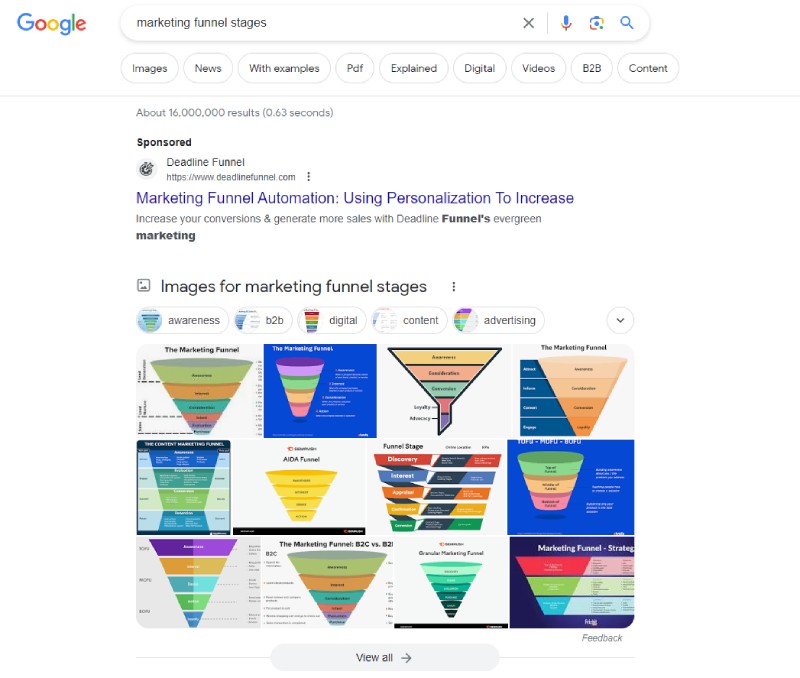
11. Videos
The 'Video’ SERPs feature is a horizontally-scrolling display of videos that appears in search engine results pages. It showcases a selection of videos related to the user's query, allowing them to preview and access video content directly from the search results without needing to visit video hosting platforms.
How to appear for Videos: Work on video content that answers popular customers queries. For example – how to videos, product explanation videos, and product reviews. Ensure transcripts and timestamps are included in your videos and that the metadata is optimised. For more tips on video SEO, consult our guide on optimising on-site videos.
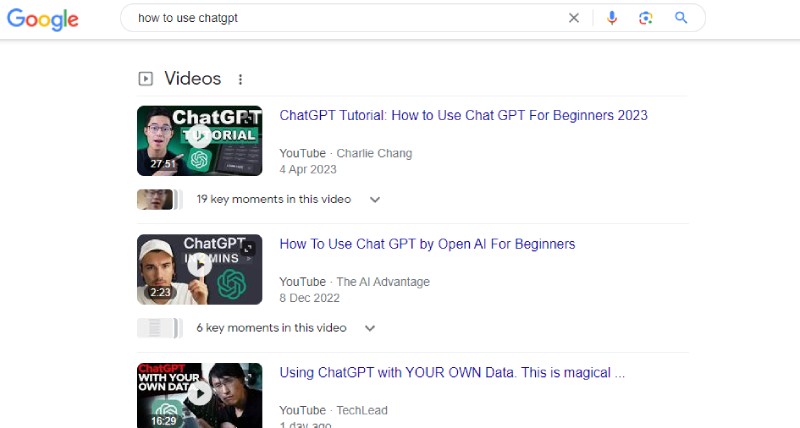
12. Sitelinks
The 'sitelinks' SERP feature refers to additional links that appear beneath the main search result listing on a search engine results page. These links, usually shown as subheadings, provide users with quick access to specific sections or pages within a website, allowing for easier navigation and direct access to relevant content.
How to appear for Sitelinks: The URL hierarchy structure of the site is important, clearly showing categories of pages – for example /clothes/women/tops. Make sure your webpages also have schema markup on and that metadata is clearly structured.
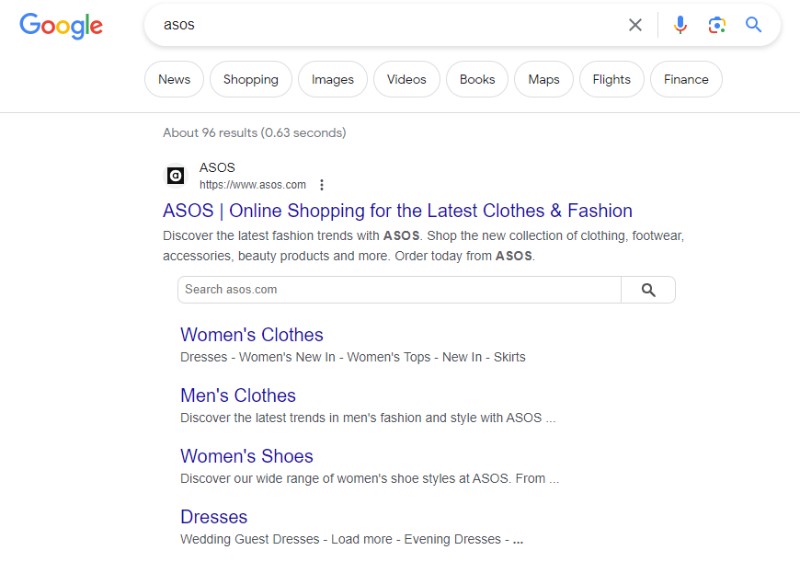
13. Twitter
The 'Twitter' SERP feature displays real-time tweets (now known as 'posts') and content from the Twitter (now 'X') platform. It provides users with recent and relevant updates, discussions, and news related to their search query, offering a dynamic and up-to-date perspective from the X community.
The below image shows how, at the time of writing, searching ‘titanic’ retrieved news items related to the missing titanic sub in the Twitter SERPs feature – over content related to the film or historic event. As a result, keeping on top of current trends provides an excellent opportunity for additional visibility on trending topics.
How to appear for Twitter SERPs feature: Work on your Twitter presence and stay up to date with current affairs. Tweet about topical issues, include hashtags, and work on building your community to be seen as a reliable source of information.
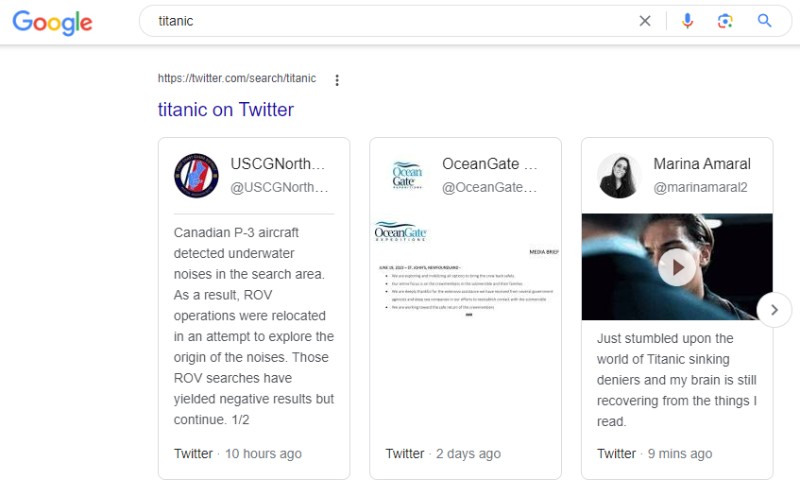
14. Scholarly Articles
The 'Scholarly Articles' SERP feature showcases academic and research papers related to a specific query. It provides users with direct access to scholarly publications, allowing them to explore in-depth and authoritative information from academic sources.
How to appear for Scholarly Articles: If your business has expertise in a particular area, uploading reports, studies or published literature to academic journals is a way to show your authority to potential readers and to appear in Scholarly Articles.

15. Related Searches
The 'Related Searches' SERP feature is a section displayed at the bottom of search engine results pages, suggesting alternative or similar queries that users may find useful. It provides users with additional search ideas or related topics to explore, helping them refine their search or discover related information.
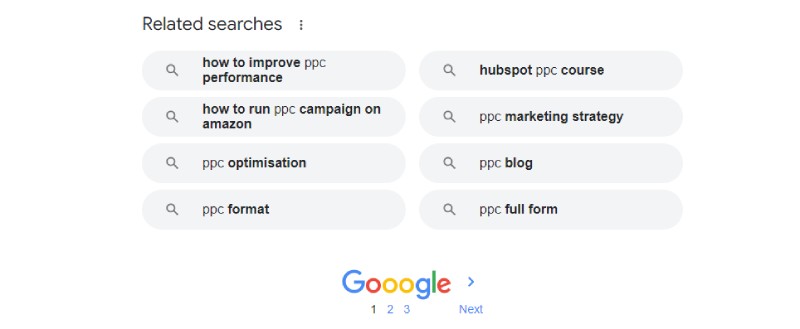
Paid Google SERP features
The following are paid SERPs features which appear in Google’s search results, but which are achieved by paying for them via Google Ads.
1. Google Search Ads
A Google ad in SERPs (Search Engine Results Pages) appears as a prominently displayed paid result at the top or bottom of the search results. It typically includes a headline, a brief description, and a URL, marked with an "Ad" label to differentiate it from organic search results.
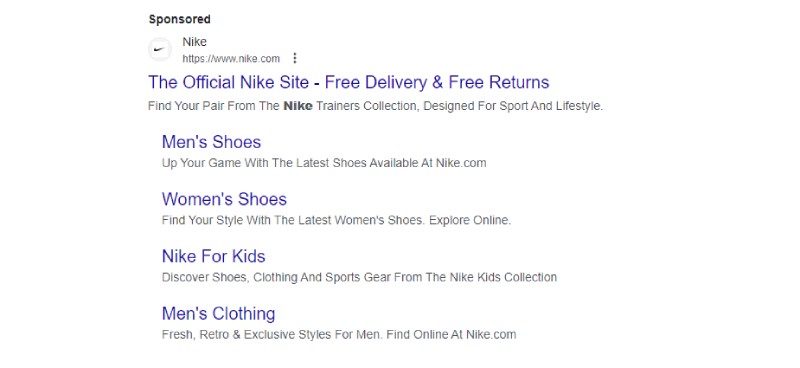
2. Google Shopping Ads
A Google Shopping ad in SERPs appears as a visually rich product listing that showcases an image, title, price, and store information. These ads are displayed at the top or side of the search results page, offering users a quick glance at various products and their prices from different retailers.
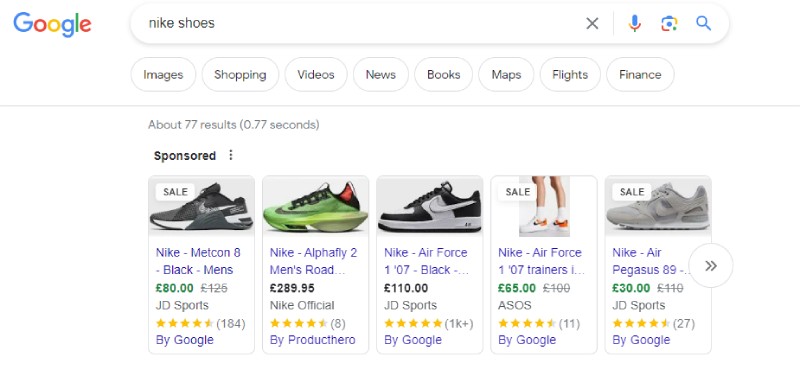
Final Word
Optimizing your content with Google’s SERPs features in mind is an excellent way to increase the chances of your content appearing higher up in search results.
For powerful, bespoke SEO strategies to improve your visibility in search results, get in touch with us today.

